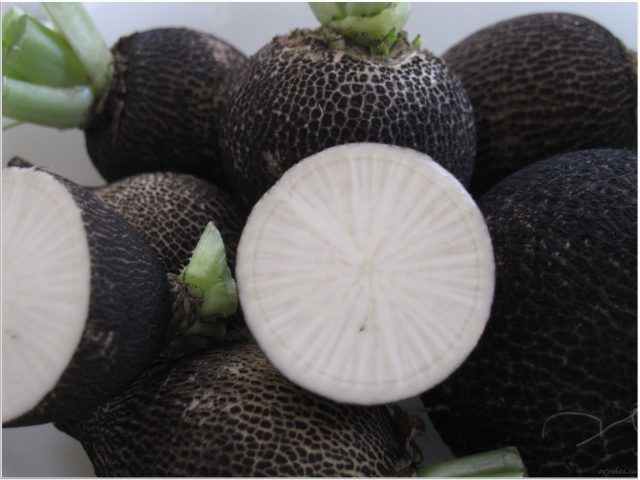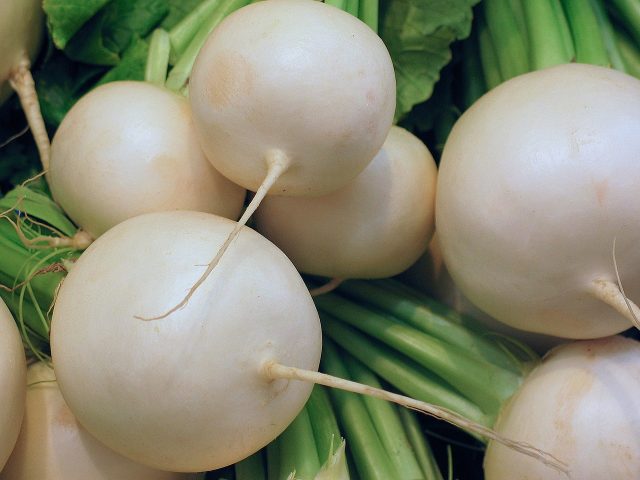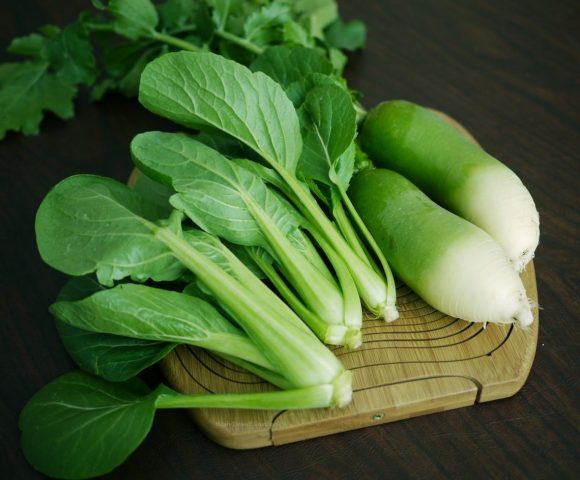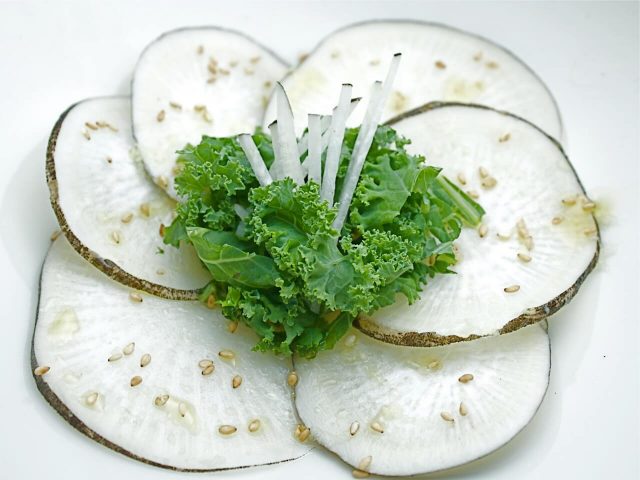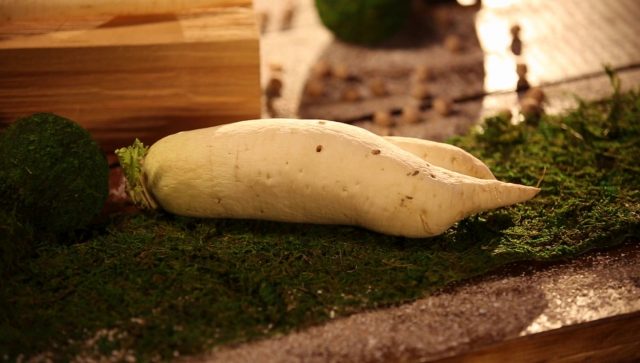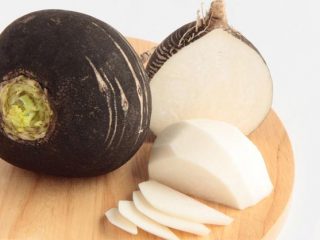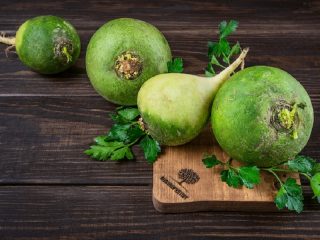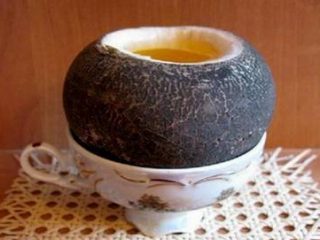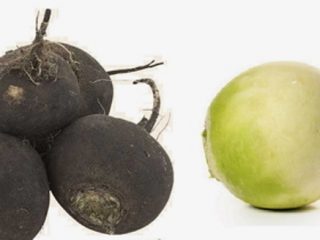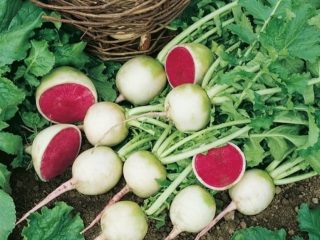Content
- 1 Chemical composition and nutritional value of radish
- 2 What are the benefits of radish for the body?
- 3 Radish: beneficial properties and contraindications
- 3.1 Can you eat radish if you have diabetes?
- 3.2 For gout
- 3.3 For the stomach
- 3.4 Is it possible to eat radish for gastritis?
- 3.5 Is it okay to eat radishes if you have a stomach ulcer?
- 3.6 For pneumonia
- 3.7 For oncology
- 3.8 Benefits of radish for the liver
- 3.9 For cholelithiasis
- 3.10 For pancreatitis
- 3.11 For a runny nose
- 3.12 For psoriasis
- 3.13 Benefits of radish for weight loss
- 4 Radish treatment
- 5 Application in cosmetology
- 6 Why does your stomach hurt after eating radishes and what to do?
- 7 Radish weakens or strengthens
- 8 Radish increases or decreases blood pressure
- 9 Contraindications for taking radish
- 10 Conclusion
The health benefits and harms of radish have been discussed by experts for a long time. People use this vegetable to treat various diseases. The root crop comes in different varieties, differing in color, shape, and ripening time. The energy value and chemical composition of all varieties are almost the same.
Chemical composition and nutritional value of radish
The vegetable contains a large amount of vitamins and microelements that are beneficial to the body. The fruits are eaten, used in cosmetology, and used as medicine. Most folk recipes are based on root vegetables. The benefits of radish for the human body are beyond doubt; it contains:
- glycosides;
- acids (organic);
- essential oils;
- food enzymes, fiber;
- amino acids.
This is the only vegetable that contains beneficial macroelements in high concentrations:
- potassium;
- iron;
- fluorine;
- sulfur;
- calcium;
- sodium;
- phosphorus;
- magnesium;
- iodine;
- zinc;
- copper;
- manganese;
- cobalt.
The healthy root vegetable contains vitamins, fats, carbohydrates, and proteins.
What vitamins do radishes have?
The main composition of vitamins in radish: carotene (beta), group B, PP, C, E, A, nicotinic, ascorbic acid, retinol, tocopherol. A set of useful substances strengthens the immune system and increases the body's resistance to viral infection. The benefits of eating the vegetable are noticeable in winter; it prevents the development of vitamin deficiency.
BJU content in radish
The concentration of proteins, fats and carbohydrates depends on the variety. Approximate composition:
Variety | Proteins % | Carbohydrates % | Fat % |
Black | 2 | 6,5 | 0,2 |
Green | 2 | 6,7 | 0,2 |
Daikon | 1,3 | 4,2 | 0 |
White | 1,6 | 4,4 | 0 |
Red | 1,0 | 3,6 | 0,2 |
Calculation per 100 g.
Radish calorie content
The vegetable does not provide any energy benefit to the body. Contains a small amount of calories. Calorie content per 100 grams rarely depends on the variety, on average it ranges from 20 to 35 kcal. Strength is restored due to the intense antibacterial effect of the root vegetable.
Which rare is healthier?
In addition to juice, the body benefits from the fibrous structure, which contains fiber necessary for digestion. Therefore, when purchasing, you need to consider density. Among vegetables of equal volume, preference is given to the heaviest.
In terms of the composition of active substances, the black variety is the leader, therefore it is considered the most useful. The downside is the bitter taste, so if there is an exacerbation of chronic diseases of the gastrointestinal tract, you should avoid using it. In this case, a white crop with a mild taste, but with less nutrients, is suitable.
What are the benefits of radish for the body?
The benefits of the vegetable extend to all body functions from immunity to the cardiovascular system. Features of radish:
- Potassium salts remove metabolic products.
- The intestinal microflora is supported by phytoncides, fiber stimulates digestion.
- Increases gastric secretion, raises low acidity levels.
- It has antibacterial properties and thins mucus in the bronchi.
- Reduces blood sugar concentration.
- Normalizes the functioning of the gallbladder.
- It has a diuretic effect, lowers blood pressure, and relieves swelling.
- Benefits for the cardiovascular system from potassium in the composition.
- The juice is used in the prevention of oncology and atherosclerosis.
What are the benefits of radish for a man's body?
The benefit of radish for men lies in the vegetable’s ability to cleanse blood vessels of cholesterol plaques and improve the elasticity of vascular walls. Blood flow is normalized, therefore, the man is not at risk of erectile dysfunction. Ascorbic acid is considered useful for thinning the blood; it relieves inflammation. Thanks to fiber, the body gets rid of toxins.The beneficial qualities of radish contribute to the necessary production of the hormone testosterone - a guarantor of full male strength. The root vegetable can be useful for men as a means of preventing baldness.
The benefits and harms of radish for women's health
Using juice with medications will help relieve vaginal trichomoniasis. It will be beneficial in the treatment of cystitis. Eating vegetables normalizes hormonal levels during the menstrual cycle.
Can radishes be consumed by pregnant women?
If pregnancy proceeds without complications, there are no contraindications, then the benefits of consuming a herbal product are much greater than the harm. It is recommended to take into account that radish tones the uterus during pregnancy, so if there is a threat of miscarriage, the vegetable is excluded from the diet. Essential oils can cause an allergic reaction. With increased acidity, the root vegetable increases the indicator, which causes unpleasant sensations.
Radish for breastfeeding
During lactation, especially in the first months, the diet of a nursing woman is selective. Not all products are allowed for consumption; radishes should be excluded from the diet. The bitter taste is transmitted through breast milk, so the baby may refuse to eat. Active substances can cause increased gas formation in a baby; essential oils cause allergies. This vegetable is strictly prohibited during breastfeeding.
At what age can a child eat radishes?
Due to its composition, the culture is useful for a growing organism:
- Increases immunity to viral infection.
- Speeds up the healing process.
- Acts as a phlegm remover.
The pharmaceutical industry fully copes with this task, producing drugs without side effects, taking into account age.
The benefits of radish will be less than the harm. Please note that allergies, indigestion, and increased gas formation are possible.
Benefits of radish for the elderly
Radish brings not only benefits, but also harm to the body of older people. Not recommended for chronic diseases:
- gastritis due to increased secretion;
- rectal dyskinesia;
- dysbacteriosis;
- stomach ulcer;
- pathologies of the cardiovascular system.
In the absence of contraindications, you can consume this healthy vegetable in unlimited quantities. The benefits include improving hematopoiesis, digestion, cleansing the liver and bile ducts. Prevents atherosclerosis, therefore, senile dementia. Strengthens bone tissue.
Radish: beneficial properties and contraindications
This is a real storehouse of vitamins and active substances, but it is not a panacea. There are a number of pathologies in which culture will not bring benefit, but will worsen the condition.
Can you eat radish if you have diabetes?
The beneficial properties of the vegetable include the ability to reduce the concentration of glucose in the blood. For type 2 diabetes mellitus, radish is recommended to be included in the daily diet. Iodine improves the functioning of the endocrine system. Lysozyme acts as a disinfectant. Insulin production improves. The glycemic index of radish is 15 units, this is an indicator for unlimited consumption of a healthy product for diabetes.
For gout
The cause of the disease is a high concentration of uric acid deposited on the joints. The benefits of radish for gout are beyond doubt. The root vegetable has a high concentration of calcium and phosphorus, which are building materials for the skeletal system. The vegetable is able to remove toxins and salts from the body. It is eaten and used as a local remedy.
For the stomach
The benefit of radish for the stomach is to improve appetite. The presence of sulfur compounds normalizes digestion. The vegetable stimulates gastric secretion, improves rectal motility, relieves constipation, and stops the fermentation process.
Is it possible to eat radish for gastritis?
For gastritis with low acidity, the benefit of the vegetable is a significant improvement in general condition. If the pathology occurs against the background of high secretion, there will be no benefit from the root vegetable; on the contrary, it will increase the amount of gastric juice secreted, and the symptoms will intensify.
Is it okay to eat radishes if you have a stomach ulcer?
The vegetable is not useful if an ulcer is diagnosed. In case of exacerbation of the pathology, use is strictly prohibited. The aggressive effect of juice on the damaged mucous membrane will cause increased pain.
For pneumonia
Traditional recipes that relieve coughs always include vegetables. Radish has an antibacterial effect for pneumonia, helps to liquefy and remove mucus from the bronchi.
For oncology
The chemical content of the root vegetable contains useful microelements that stop the growth of cancer cells. In oncology, radish is used for preventive and therapeutic purposes for tumors in the uterus, breast tumors, and hardening of the prostate gland.Tinctures and decoctions are taken orally or as lotions and rubbing.
Benefits of radish for the liver
The juice is suitable for the prevention and treatment of hepatitis and cirrhosis. Choline (vitamin B4) stimulates the production of phospholipids; enzyme deficiency leads to fatty degeneration of the organ. Vitamin C improves liver function by increasing glycogen concentration.
For cholelithiasis
The pathology is caused by the formation of calcium deposits in the gallbladder and excretory ducts. The benefit of radish for cholelithiasis is the removal of bilirubin formations, crushing existing ones and preventing the appearance of new fragments.
For pancreatitis
The benefit of radish for pancreatitis is to normalize the function of the endocrine system. Thanks to its antibacterial properties, the root vegetable prevents the development of necrosis. Strengthens the recovery process of damaged pancreatic cells. During the acute stage, it is not recommended to consume vegetables.
For a runny nose
Rhinitis and sinusitis are accompanied by secretion from the nasal sinuses. The cause of the anomaly in most cases is a viral infection. Radish has the ability to kill pathogenic flora, which allows you to get rid of a runny nose. The juice is dropped into the nose and taken orally to strengthen the immune system's resistance to viruses.
For psoriasis
Psoriasis is a chronic pathology of an infectious nature. Manifested by damage to the epidermis. Radish for psoriasis acts as a useful topical remedy. Eliminates itching and redness in problem areas. Improves the peeling of skin fragments from the lesion (papules).
Benefits of radish for weight loss
For a person on a diet, radish is a must-have product for weight loss.The vegetable is low in calories and removes excess fluid from the body and tissues. Clears away decay products formed during the metabolic process. Normalizes the functioning of the gastrointestinal tract, prevents constipation. Supplies the body with vitamins and beneficial microelements necessary for life.
Radish treatment
The root vegetable has found wide use in alternative medicine for the treatment of various diseases. It is used separately or as an ingredient in a medicinal composition.
The use of radish in folk medicine
In alternative medicine, all parts of the root vegetable are used for treatment; a large concentration of beneficial substances is found in the juice of the vegetable crop. Radish is used to treat:
- viral and bacterial infection;
- digestive tract dysfunction;
- cleanse blood vessels and liver;
- eliminate joint problems.
How to treat sinusitis with radish
There are several useful ways to get rid of sinusitis:
- For two weeks before going to bed, drip 4 drops of radish juice into each nasal passage, then seal it with a cotton swab.
- Use crushed root vegetables mixed with vegetable oil as a compress on the sinus area for a course of 7 days. After the procedure, it is recommended not to go out into fresh air for 2 hours.
The procedures alleviate symptoms and prevent complications from developing.
Liver cleansing with radish
The benefit of radish in cleansing the liver is its ability to speed up detoxification by intensively removing bile. Use root juice. The course is 1.5 months. Apply 30 minutes after meals, 3 times a day. Dosage regimen: 14 days, 1 tbsp.l, the next two weeks, 2 tbsp. l, remaining days 3 tbsp. l.
Cleaning blood vessels with radish
The beneficial properties of radish help in cleaning blood vessels. Squeeze out the juice, add lemon and honey. For 0.5 liters of juice you will need 100 g of honey and one chopped lemon. Infuse the product in the refrigerator (24 hours). Drink in a course - 21 days, 1 tbsp. l morning, afternoon and evening after meals.
Treatment of heel spurs with radish
Pass the root vegetable through a meat grinder, place the substance in a glass container, add 1/3 of the mass with alcohol. Leave for 15 days in the refrigerator. Wring out, apply the mixture in an even layer on the heel, wrap it with cellophane and a warm scarf on top. Leave it overnight. In the morning, remove the compress and rub it with alcohol from the tincture. Course – 2 weeks.
Application in cosmetology
Radish juice has the beneficial property of lightening the skin and eliminating pockets of bacterial infection. The seeds and pulp of the root vegetable are used for cosmetic purposes. Vegetable crops are effective in the following cases:
- To strengthen hair follicles. It is necessary to rub the juice of the root vegetable into the scalp.
- For skin pigmentation. Stains are removed with a mask of vegetable pulp. Infuse the seeds in alcohol and treat the skin with a cotton swab before going to bed.
- For acne. An alcoholic tincture of seeds mixed in equal proportions with juice is used to wipe problem areas.
- For dark circles under the eyes. You can eliminate them with lotions made from root juice.
Why does your stomach hurt after eating radishes and what to do?
The healthy vegetable contains microelements that irritate the mucous membrane. After consumption, peristalsis increases, the cavity moves the contents to the rectum. If your stomach hurts from radish, this may be a symptom of pathological changes in the gastrointestinal tract.The painful syndrome at the first stage of peptic ulcer disease rarely appears, and eating root vegetables provokes discomfort. To prescribe therapy, an examination is necessary. If the pain is severe, it is recommended to take an antispasmodic drug.
Radish weakens or strengthens
Delayed bowel movements indicate problems with digestion; there can be several reasons for the abnormal phenomenon: from an incorrect diet to a deficiency of certain enzymes. The benefit of the culture is that it does not cause diarrhea and gently relieves the symptoms of constipation. Thanks to fiber, which is beneficial for the gastrointestinal tract, peristalsis improves and dysbiosis is stopped. If you have irritable bowel syndrome, eating vegetables is not recommended; there will be no benefit, but harm.
Radish increases or decreases blood pressure
The healthy vegetable contains potassium, which improves the condition of blood vessels and rids the body of cholesterol. The lumen of the arteries increases, blood flow normalizes. Blood pressure drops in hypertension. The root vegetable removes excess fluid, which also helps lower blood pressure. For arterial hypertension, the benefits of culture are undeniable. In the case of hypotensive patients, the vegetable normalizes blood pressure, not lowers it.
Contraindications for taking radish
Vegetables are excluded from the menu if the following pathologies are diagnosed:
- gastritis due to increased acidity;
- stomach and duodenal ulcers;
- chronic heart pathology (previous heart attack);
- glomerular nephritis in the acute stage;
- irritable bowel syndrome;
- pathological pregnancy;
- exacerbation of liver diseases.
There is an age limit; no matter what the benefits, it is not recommended for children under 4 years of age to consume radish.
Can you be allergic to radish?
The healthy vegetable contains essential oils and beta-carotene, which are allergens. This is one of the reasons why the vegetable should not be given to young children, as well as to people with allergies.
Conclusion
The health benefits and harms of radish are individual in each case. If there are no chronic diseases, the benefits of root vegetables are beyond doubt. The chemical composition has a beneficial effect on all functional areas of the body.
